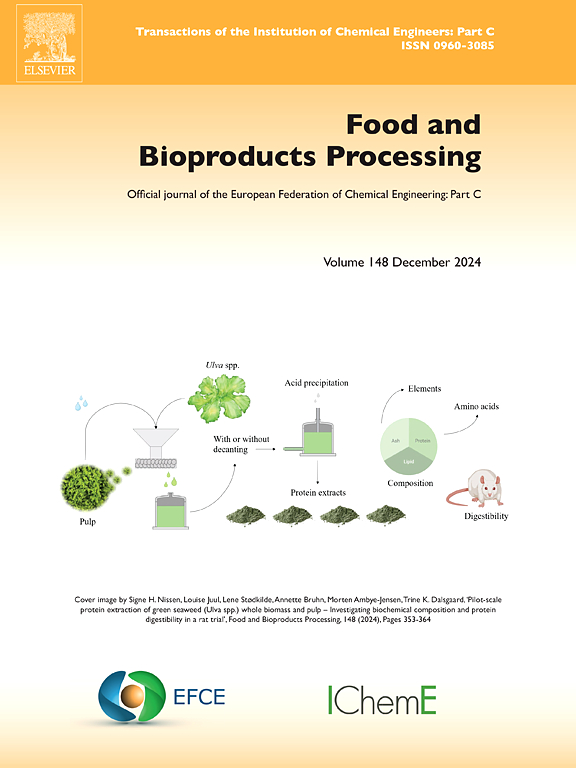通过挤压蒸煮生成 3D 食品打印材料:富含欧米茄-3 的鹰嘴豆面粉配方的可打印性和流变特性
IF 3.4
2区 农林科学
Q2 BIOTECHNOLOGY & APPLIED MICROBIOLOGY
引用次数: 0
摘要
虽然研究深入,但与传统的食品制造方法相比,3D食品打印(3DFP)兼容材料的清单仍然很短。研究了富含omega-3油的鹰嘴豆粉的印刷性能,以及挤压加工对印刷性能的影响。挤压加工的功能和营养优势为3D食品打印产生了新的材料。使用了四种面粉:NE(非挤压)、NEO(富油)、E(挤压)和EO(富油)。14种配方(NE和NEO为34-36-40 %,E和EO为66-68-70-72 %)的含水量各不相同,均在T1-25ºC和T2-35ºC两种温度下印刷。对印花的尺寸精度进行了评估,以找到每种面粉类型的最佳配方。在每种材料的俯视图可打印性中,根据最小的误差百分比,对四种最佳配方进行了流变学表征(振幅扫描、剪切粘度、时间粘度、温度粘度和回收率)。根据可打印性,最佳配方为NE-36-T1(非挤压样品,含水量为36% %,25ºC打印)和E-72-T1(挤压样品,含水量为72 %,25ºC打印),打印偏差最小(29.03和30.07)。Omega-3富集显著降低了屈服应力(NE-36为3262 Pa, NEO-36为2831 Pa, E-72为3304 Pa, EO-72为1766 Pa)。所有配方均保持粘弹性,EO-72的回收率最低。这些结果表明挤压鹰嘴豆粉和非挤压鹰嘴豆粉与3DFP的相容性,使其进一步整合为更复杂的配方中的成分。本文章由计算机程序翻译,如有差异,请以英文原文为准。
Generating 3D food printing materials through extrusion cooking: Printability and rheological properties of omega-3-enriched and chickpea flours formulations
Although deeply studied, the list of 3D Food Printing (3DFP) compatible materials is still short compared to traditional food manufacturing methods. This study focused on the printability of chickpea flour enriched with omega-3-rich oil and the effect of extrusion processing on printability. The functional and nutritional advantages of extrusion processing generated novel materials for 3D food printing. Four flours were used: NE (non-extruded), NEO (oil enriched), E (extruded), and EO (oil enriched). The water content varied across 14 formulations (34–36–40 % for NE and NEO and 66–68–70–72 % for E and EO), all printed at two temperatures (T1–25 ºC and T2–35 ºC). The prints’ dimensional accuracy was assessed to find the best formulation for each flour type. Following the least percentage error in each material´s top-view printability, the four best formulations were rheologically characterized (amplitude sweep, shear-viscosity, time-viscosity, temperature-viscosity, and recovery). Based on printability, the best formulations were NE-36-T1 (non-extruded sample with 36 % water content printed at 25 ºC) and E-72-T1 (extruded sample with 72 % water content printed at 25 ºC), yielding the lowest printing deviations (29.03 and 30.07). Omega-3 enrichment significantly decreased the yield stress (3262 Pa for NE-36 to 2831 Pa for NEO-36, and 3304 Pa for E-72 to 1766 Pa for EO-72). All formulations remained viscoelastic, with EO-72 having the lowest recovery percentage. These results showed the compatibility of extruded and non-extruded chickpea flour with 3DFP, granting their further integration as ingredients in more complex formulations.
求助全文
通过发布文献求助,成功后即可免费获取论文全文。
去求助
来源期刊

Food and Bioproducts Processing
工程技术-工程:化工
CiteScore
9.70
自引率
4.30%
发文量
115
审稿时长
24 days
期刊介绍:
Official Journal of the European Federation of Chemical Engineering:
Part C
FBP aims to be the principal international journal for publication of high quality, original papers in the branches of engineering and science dedicated to the safe processing of biological products. It is the only journal to exploit the synergy between biotechnology, bioprocessing and food engineering.
Papers showing how research results can be used in engineering design, and accounts of experimental or theoretical research work bringing new perspectives to established principles, highlighting unsolved problems or indicating directions for future research, are particularly welcome. Contributions that deal with new developments in equipment or processes and that can be given quantitative expression are encouraged. The journal is especially interested in papers that extend the boundaries of food and bioproducts processing.
The journal has a strong emphasis on the interface between engineering and food or bioproducts. Papers that are not likely to be published are those:
• Primarily concerned with food formulation
• That use experimental design techniques to obtain response surfaces but gain little insight from them
• That are empirical and ignore established mechanistic models, e.g., empirical drying curves
• That are primarily concerned about sensory evaluation and colour
• Concern the extraction, encapsulation and/or antioxidant activity of a specific biological material without providing insight that could be applied to a similar but different material,
• Containing only chemical analyses of biological materials.
 求助内容:
求助内容: 应助结果提醒方式:
应助结果提醒方式:


